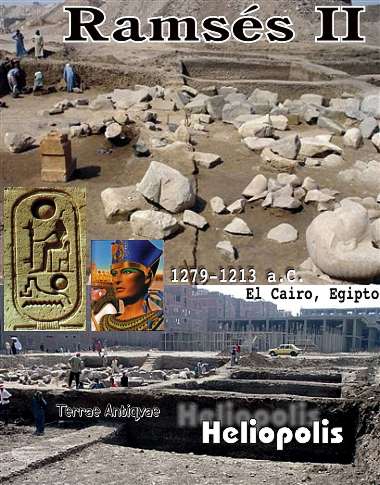Egipto. Descubren templo con estatuas de Ramsés II en El Cairo

Fotos: (1) A picture released by the Egyptian Antiquities 27 February 2006, shows the site of an ancient solar temple that has been discovered beneath a flea market in a Cairo suburb. Royal statues in pink-coloured granite, probably from the time of Ramses II (13th century BC) and weighing five tonnes, were found in the temple and are now in the custody of the Council of Antiquities. The suburb of Ein Shams (eye of the sun) was built on top of the ancient city of Heliopolis, meaning city of the sun in Greek, and was famed for its theology and philosophy schools. AFP PHOTO/EGYPTIAN SUPREME COUNCIL OF ANTIQUITIES/HO (Photo credit should read -/AFP/Getty Images) (2) A picture released by the Egyptian Antiquities 27 February 2006 shows parts of a statue believed to be the head of 19th Dynasty Pharaoh Ramses II. The statue was recently discovered beneath a flea market in the Cairo suburb of Ain Shams (Sun Spring). Ramses II ruled Egypt for 66 years from 1279 BC to 1213 BC and was known as the Builder King because of the number of temples and monuments he built for himself during his long reign.
Aseguran expertos que el descubrimiento forma parte del grupo de santuarios dedicados al culto del Sol que fueron construidos en la zona, la antigua Heliopolis.
Giant Ancient Egyptian Sun Temple Discovered in Cairo
Un equipo de arqueólogos egipcios descubrió en un barrio de El Cairo los vestigios de un templo de la época del Imperio Medio y Nuevo que estaba decorado con estatuas del faraón Ramsés II (1304 a.C-1237 a.C), informaron fuentes del Consejo Supremo de Antigüedades (CSA).
El templo, que fue hallado en el populoso barrio cairota de Ein Shams, forma parte del conjunto de templos que fueron dedicados al culto del Sol en la zona, declaró el experto del CSA Rida Suleimán.
En el lugar se encontraron tres estatuas con las facciones del faraón Ramsés II, entre ellas una esculpida en granito rosa, con un peso de entre cinco y seis toneladas y una altura de tres a cuatro metros, dijo el experto.
Suleimán indicó que las otras dos esculturas de Ramsés II corresponden a un busto, también en granito rosado, de 2.5 toneladas de peso, y una estatua sedente esculpida en piedra arenisca, en cuya espalda se grabaron jeroglíficos.
La cuarta pieza, esculpida en granito rosa y que pesa entre una y dos toneladas, representa al faraón Sesostris I, perteneciente a la XII dinastía del Imperio Medio, que gobernó Egipto entre los años 2040 y 1777 antes de Cristo, agregó Suleiman.
El experto del CSA informó de que también se descubrió un conjunto de pequeñas figuras en piedra caliza que datan del rey Amenofis IV, de su esposa Nefertiti, y su suegra Titi, que datan de la XVII dinastía.
Donde ahora se encuentra Ein Shams, se hallaba el santuario de Un, el centro de culto solar más importante del dios solar Ra en la era predinástica. También Un se destacó porque sus sacerdotes inventaron el primer calendario solar, y porque acogió la primera universidad del mundo que enseñó la ciencia de la astronomía.
Fuente: Agencia EFE / El Universal, 26 de febrero de 2006
Enlace: http://estadis.eluniversal.com.mx/notas/332906.html
-------------------------------
Ancient Sun Temple Uncovered in Cairo
CAIRO, Egypt, Feb. 27, 2006
(AP) Archaeologists discovered a pharaonic sun temple with large statues believed to be of King Ramses II under an outdoor marketplace in Cairo, Egypts antiquities chief said Sunday.
The partially uncovered site is the largest sun temple ever found in the capitals Aim Shams and Matariya districts, where the ancient city of Heliopolis _ the center of pharaonic sun worship _ was located, Zahi Hawass told The Associated Press.
Among the artifacts was a pink granite statue weighing 4 to 5 tons whose features "resemble those of Ramses II," said Hawass, head of the Supreme Council of Antiquities.
Also found was a 5-foot-high statue of a seated figure with hieroglyphics that include three tablets with the name of Ramses II _ and a 3-ton head of royal statue, the council said in a statement.
The green pavement stones of the temples floor were also uncovered.
An Egyptian team working in cooperation with the German Archaeological Mission in Egypt discovered the site under the Souq al-Khamis, a popular market in eastern Cairo, Hawass said.
"The market has to be removed" as archeologists excavate the entire site, Hawas said.
King Ramses II, who ruled Egypt for 66 years from 1270 to 1213 B.C., had erected monuments up and down the Nile with records of his achievements, as well as building temples _ including Abu Simbel, erected near what is now Egypts southern border.
Numerous temples to Egypts sun gods _ particularly the chief god Ra _ were built in ancient Heliopolis. But little remains of what was one the ancient Egyptians most sacred cities, since much of the stone used in the temples was later plundered.
The area is now covered with residential neighborhoods, close to a modern district called Heliopolis, in Egypts packed capital.
Fuente: http://www.cbsnews.com/stories/2006/
02/27/ap/tech/mainD8G16G2O0.shtml
6 comentarios
luis miguel navarro castillo -
karla garcia -
gius -
adios de un futuro arqueólogo
SARAI -
Una Amante de la Historia -
Arturo Gómez -
Arturo Gómez
http://www.poblamerica.blogspot.com